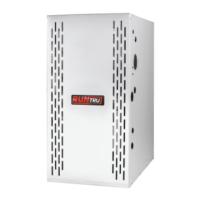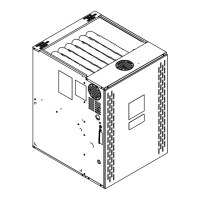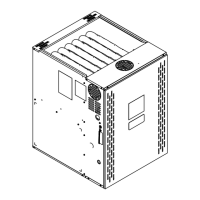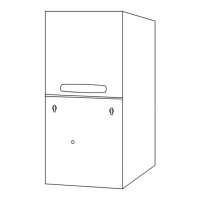Do you have a question about the Trane A801X026AM2SC and is the answer not in the manual?
Introduces gas-fired furnaces for upflow/downflow/horizontal use.
Alerts to hazards for qualified personnel working on equipment.
Warns about flammable vapors, gas leaks, and improper lighting.
Covers shock, fire, explosion, and CO poisoning risks.
Notifies about exposure to chemicals known to cause cancer or reproductive harm.
Details explosion, electrical shock, fire, and carbon monoxide precautions.
Covers explosion, safety, shock, overheating, and improper voltage hazards.
Addresses sharp edges, wrench use, freeze protection, and ignition function cautions.
Warns about UV light damage and critical carbon monoxide poisoning hazards from venting.
Lists furnace accessories, their descriptions, and compatible models.
Details included documentation and major furnace components.
Provides technical data for A801X furnace models, including ratings and blower specs.
Continues technical data for larger A801X furnace models.
Outlines essential safety rules for furnace installation, servicing, and operation.
Covers codes, heating requirements estimation, and material inspection for installation.
Specifies minimum clearances to combustible materials for various installation orientations.
Lists substances that can cause furnace issues if present in combustion air.
Provides detailed dimensions for various furnace cabinet sizes.
Illustrates thermostat, furnace, and outdoor unit wiring connections, including IFC layout.
Presents CFM vs. external static pressure data for A801X026AM2SC and A801X040AM3SC models.
Provides CFM vs. external static pressure for A801X040BM2SC, A801X060BM4SC, A801X080BM4SC models.
Lists temperature rise values for various CFM inputs across different furnace models.
Instructions for removing the furnace front panel for access.
Details how to install furnaces horizontally in attics, crawl spaces, or suspended.
Illustrates various gas piping connections for upflow and downflow furnace orientations.
Shows gas piping configurations for horizontal furnace orientations.
Provides pipe sizing tables, orifice sizes for gas types, and conversion kit information.
Outlines steps for verifying furnace gas input rate and proper combustion.
Details gas flow rates and procedures for adjusting the gas valve manifold pressure.
Explains how to adjust furnace input rate for high altitudes and select replacement orifices.
Discusses options and considerations for venting into masonry chimneys.
Covers requirements for venting into internal masonry chimneys.
Warns about chimney liner integrity and potential CO poisoning.
Recommends practices to minimize corrosion in external masonry chimneys.
Specifies minimum vent termination heights based on roof pitch and vertical wall distance.
Details requirements for providing adequate air for furnace combustion and ventilation.
Illustrates methods for providing ventilation air in confined spaces.
Explains standards and considerations for installing air duct systems.
Shows how to connect supply ducts to furnaces when an evaporator coil is installed.
Provides instructions for connecting supply ducts when no evaporator coil is used.
Lists general guidelines for connecting return air duct systems to furnaces.
Illustrates various return duct configurations for upflow furnaces.
Shows connection methods for downflow furnaces with top returns.
Details how to install external return air filters for upflow furnaces.
Explains filter installation requirements for horizontal furnace configurations.
Covers wiring practices, grounding, and field wiring diagrams for thermostats.
Illustrates wiring diagrams for connecting two furnaces in a twinning configuration.
Lists essential checks before initiating furnace start-up.
Guides through the furnace lighting sequence and basic operation.
Details how to verify the proper operation of limit switches and safety devices.
Shows approved venting configurations for upflow furnace installations.
Illustrates approved venting options for horizontal left furnace installations.
Depicts approved venting configurations for horizontal right furnace installations.
Shows approved venting configurations for downflow furnace installations.
Explains how to convert combustion air settings for different venting orientations.
Provides specific installation instructions for combustion air conversions.
Covers system setup, clearing faults, and factory default resets.
Details how to select fan speeds for cooling/heat pump and gas heating modes.
Explains how to enter and use the furnace's run test mode.
Describes status codes displayed on the IFC for various operating conditions.
Provides specific dimension measurements for belly band placement on motors for vibration control.
Guides on measuring external static pressure and adjusting airflow using tap settings.
Lists IFC menu options and provides explanations for alarm error codes.
Details steps for viewing, clearing faults, and resetting IFC to factory defaults.
Lists available troubleshooting flowcharts and corresponding error codes.
Provides a detailed diagram of the IFC component layout and terminal connections.
A flowchart to diagnose basic furnace startup and electrical issues.
Specific steps for diagnosing and resolving the E01 fault code for internal IFC failure.
Troubleshoots issues related to flame sensing and ignition, including fault code E2.1.
Addresses troubleshooting for manifold pressure issues and fault code E2.2.
Details troubleshooting steps for gas valve operation and fault code E2.3.
Guides on troubleshooting fault code 3.1 related to the pressure switch being closed when open.
Covers troubleshooting for fault code 3.2 involving inducer motor and pressure switch operation.
Diagnoses fault code 4.0 related to limit switches, rollout switches, and airflow.
Focuses on troubleshooting flame rollout and burner flame patterns (fault code 4.0).
Addresses fault code 05 where flame is sensed when it should not be, or flame current is low.
Guides on diagnosing and correcting incoming high voltage polarity faults.
Explains how to troubleshoot ground faults where chassis ground is not sensed.
Details troubleshooting steps for igniter relay faults and igniter circuit problems.
Covers troubleshooting for fault code 7.1, an external gas valve circuit error.
Diagnoses fault code 08 related to low flame sense current.
Addresses fault code 11 where IFC detects internal gas valve relay failures.
Guides on troubleshooting fault code 12 related to the onboard 5 amp fuse.
Provides steps to troubleshoot issues with the constant torque blower motor.
Describes the step-by-step process of gas heating operation.
Explains the operational sequence for cooling and heat pump modes.
Outlines annual maintenance tasks for furnace components including inspection, cleaning, and replacement.
| Model Number | A801X026AM2SC |
|---|---|
| Category | Furnace |
| Type | Gas |
| Input BTU | 26, 000 |
| AFUE | 80% |
| Blower Motor | Multi-Speed |
| Ignition | Hot Surface Ignition |
| Vent Diameter | 4 inches |
| Furnace Type | Upflow/Horizontal |
| Stages | Single Stage |












